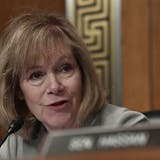Members of the House Transportation and Finance Committee will have plenty of issues to talk about during the 2022 legislative session, and improving road safety will be at the top of the list.
The topic is front and center for committee Chair Frank Hornstein after Minnesota recorded nearly 500 traffic fatalities and 58 pedestrian deaths last year, the most in both categories in recent years.
"I feel this issue is so urgent that it should be at the top of any transportation agenda," he said.
The sobering spike in numbers that mirror a nationwide trend led Hornstein to hold two recent virtual hearings in which local and national transportation experts, traffic safety advocates and crash victims implored legislators to make safety the No. 1 priority when considering new traffic laws and appropriating funds.
Lawmakers face myriad challenges, but they will have some money to work with. President Joe Biden's Infrastructure Investment and Jobs Act, which includes money for highways, highway safety and transit programs, will send millions of dollars to Minnesota.
Traffic safety officials have ideas for some of it. Col. Matt Langer of the State Patrol spoke for the need to increase enforcement to combat bad and risky driving behavior, particularly speeding, as the State Patrol issued more than 1,420 citations to motorists caught driving over 100 mph last year while the total number of traffic citations issued by Minnesota law enforcement statewide declined.
"Traffic enforcement does relate to keeping roads safe" he said.
Rodney Seurer, the police chief in Savage, said more cameras along highways could help with crash investigations and educating drivers on traffic safety.


